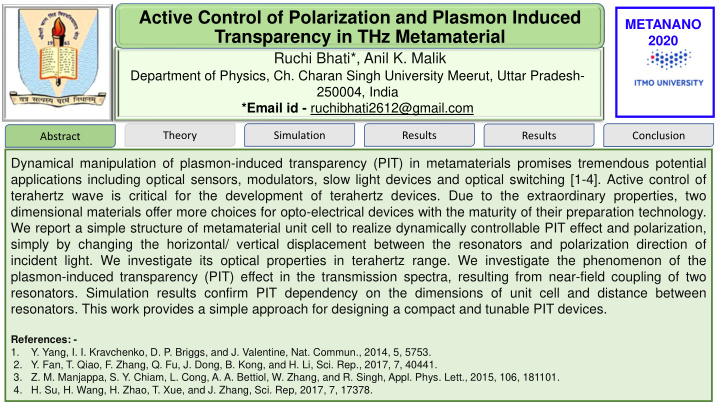



Active Control of Polarization and Plasmon Induced METANANO Transparency in THz Metamaterial 2020 Ruchi Bhati*, Anil K. Malik Department of Physics, Ch. Charan Singh University Meerut, Uttar Pradesh- 250004, India *Email id - ruchibhati2612@gmail.com Theory Simulation Results Results Conclusion Abstract Dynamical manipulation of plasmon-induced transparency (PIT) in metamaterials promises tremendous potential applications including optical sensors, modulators, slow light devices and optical switching [1-4]. Active control of terahertz wave is critical for the development of terahertz devices. Due to the extraordinary properties, two dimensional materials offer more choices for opto-electrical devices with the maturity of their preparation technology. We report a simple structure of metamaterial unit cell to realize dynamically controllable PIT effect and polarization, simply by changing the horizontal/ vertical displacement between the resonators and polarization direction of incident light. We investigate its optical properties in terahertz range. We investigate the phenomenon of the plasmon-induced transparency (PIT) effect in the transmission spectra, resulting from near-field coupling of two resonators. Simulation results confirm PIT dependency on the dimensions of unit cell and distance between resonators. This work provides a simple approach for designing a compact and tunable PIT devices. References: - 1. Y. Yang, I. I. Kravchenko, D. P. Briggs, and J. Valentine, Nat. Commun., 2014, 5, 5753. 2. Y. Fan, T. Qiao, F. Zhang, Q. Fu, J. Dong, B. Kong, and H. Li, Sci. Rep., 2017, 7, 40441. 3. Z. M. Manjappa, S. Y. Chiam, L. Cong, A. A. Bettiol, W. Zhang, and R. Singh, Appl. Phys. Lett., 2015, 106, 181101. 4. H. Su, H. Wang, H. Zhao, T. Xue, and J. Zhang, Sci. Rep, 2017, 7, 17378.
Active Control of Polarization and Plasmon Induced Transparency in THz Metamaterial Ruchi Bhati*, Anil K. Malik Abstract Theory Simulation Results Results Conclusion THz Metamaterials Plasmon induced transparency ❖ THz region is located at the interface of ❖ Plasmon-induced transparency (PIT) is analogous effect to the electronics and photonics. This gap is classical quantum electromagnetically induced transparency caused by weak/nonexistent materials (EIT) phenomenon. It results from the destructive interference response at THz frequencies. between two resonances, which are coupled to the radiation field on one chip ❖ Results in a lack of sources, detectors, sensors, modulators, polarizers, filters, etc. ❖ PIT is an effective strategy to control the transmission This phenomenon has potential applications for designing nanosensors in the THz regime. properties of the incident THz wave with designed metasurface with high performance due to the sharp resonance of the light near the structures by adjusting the geometric parameters and varying appeared transparency window ❖ Metamaterials (MMs) may help to get over the distance between two resonators. this dilemma because MMs are artificially engineered materials with properties derived ❖ This phenomenon has potential applications for designing from their sub-wavelength structures, rather nanosensors with high performance due to the sharp than the materials from they are made of. resonance of the light near the appeared transparency window e.g., simultaneously ε <0 and µ<0 → n< 0.
Active Control of Polarization and Plasmon Induced Transparency in THz Metamaterial Ruchi Bhati*, Anil K. Malik Introduction Theory Simulation Results Results Conclusion Geometry of the Metamaterial unit cell CST results for amplitude transmission h Substrate Graphene R P S P P Fig. 2 The normalized transmission curves of transverse electric(TE) and magnetic(TM) mode(Blue curve shows the TE Fig.1 Schematic diagram of metamaterial unit cell mode while Red curve shows the TM mode). geometry. The geometrical parameters of unit cell are It depicts that our proposed metamaterial unit cell is insensitive :-P=30µm, S=14.5µm, R=2.6µm, h= 10µm and for the direction of polarization . separation between two resonators are 0.5µm
Active Control of Polarization and Plasmon Induced Lab Transparency in THz Metamaterial symbolics Ruchi Bhati*, Anil K. Malik Introduction Theory Simulation Results Conclusion Results Transmission spectra for different horizontal displacement Transmission Hd Fig. 3. Transmission versus Frequency spectra for different horizontal displacement(Hd) between Hd upper and lower resonators. This curve represents that as Hd is increases 2 nd resonant frequency decreases and at Hd=7µm, it disappears completely and we get only a single transparency window. Frequency(THz)
Active Control of Polarization and Plasmon Induced Lab Transparency in THz Metamaterial symbolics Ruchi Bhati*, Anil K. Malik Abstract Theory Simulation Results Results Conclusion Transmission spectra for different vertical displacement (a) (b ) Transmission Vd Vd Transmission Frequency(THz) Frequency(THz) Fig. 4 Transmission amplitude curve for different vertical displacement between left and right resonators. increases 1 st Fig.4(a) curve represents that as Vd resonant frequency decreases and at Vd=2µm, it disappears completely and we get only a single transparency window. Fig. 4(b) shows that at V=7µm Frequency(THz) both the transparency window disappears and we get only single resonant frequency.
Activ ive Con ontrol l of of Pol olarization an and Plas lasmon In Induced Tran ansparency METANANO in in THz Metamateria ial 2020 Ruchi Bhati, Anil K. Malik Department of Physics, Ch. Charan Singh University Meerut, Uttar Pradesh-250004, India Email id - ruchibhati2612@gmail.com Abstract Theory Simulation Results Results Conclusion In this work, we have numerically investigated the tunable plasmonic induced transparency based on graphene patterns in terahertz regime, including the effect of structural parameters and direction of polarization. Conclusions of this work are as follows :- ➢ Our proposed MM unit cell is insensitive to the direction of polarization. ➢ By changing the horizontal displacement between upper and lower side resonators, we can actively control the first transparency window. ➢ Second transparency window can be tuned by varying the vertical displacement between left and right side resonators of MM unit cell. ➢ The independent modulation of the PIT transparency windows will provide us the flexibility to choose the desired frequency for device designing and construction.
Recommend
More recommend